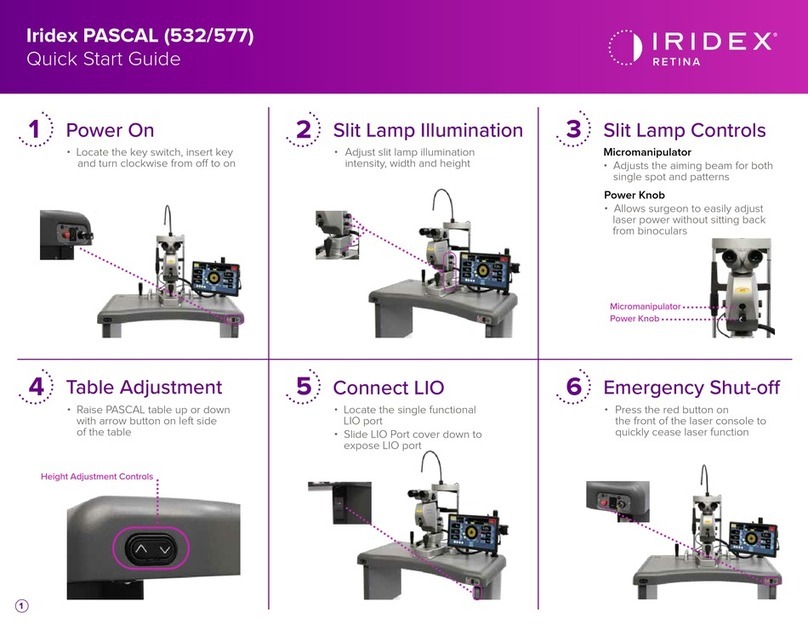References
1. Sasoh M, Smiddy W: Diode Laser Endophotocoagulation. Retina 1995;15(5):388-393.
2. Akduman, L, Olk, RJ: Diode Laser (810 Nm) Versus Argon Green (514 Nm) Modified Grid Photocoagulation
for Diffuse Diabetic Macular Edema. Ophthalmology 1997;104(9):1433-41.
3. Ulbig MW, McHugh DA, Hamilton AM: Diode Laser Photocoagulation for Diabetic Macular Oedema.
Br J Ophthalmol 1995;79(4):318-21.
4. Luttrull JK, Sramek C, Palanker D, Spink CJ, Musch DC: Long-Term Safety, High-Resolution Imaging, and
Tissue Temperature Modeling of Subvisible Diode Micropulse Photocoagulation for Retinovascular Macular
Edema. Retina 2012;32(2):375-86.
5. Vujosevic S, Bottega E, Casciano M, Pilotto E, Convento E, Midena E: Microperimetry and Fundus
Autofluorescence in Diabetic Macular Edema: Subthreshold Micropulse Diode Laser Versus Modified Early
Treatment Diabetic Retinopathy Study Laser Photocoagulation. Retina 2010;30(6):908-916.
6. Agarwal HC, Poovali S, Sihota R, Dada T: Comparative Evaluation of Diode Laser Trabeculoplasty Vs.
Frequency Doubled Nd : YagLaser Trabeculoplastyin PrimaryOpenAngleGlaucoma.Eye2006;20(12):1352-6.
7. Chung PY, Schuman JS, Netland PA, Lloyd-Muhammad RA, Jacobs DS: Five-Year Results of a Randomized,
Prospective, Clinical Trial of Diode Vs Argon Laser Trabeculoplasty for Open-Angle Glaucoma.
Am J Ophthalmol 1998;126(2):185-90.
8. Panarelli, JF, Banitt, MR, Sidoti, PA: Transscleral Diode Laser Cyclophotocoagulation after Baerveldt
Glaucoma Implant Surgery. J Glaucoma 2012.
9. Wilensky, JT, Kammer, J: Long-Term Visual Outcome of Transscleral Laser Cyclotherapy in Eyes with
Ambulatory Vision. Ophthalmology 2004;111(7):1389-92.
10. Schlote T, Derse M, Rassmann K, Nicaeus T, Dietz K, Thiel HJ: Efficacy and Safety of Contact Transscleral
Diode Laser Cyclophotocoagulation for Advanced Glaucoma. J Glaucoma 2001;10(4):294-301.
11. Haller JA, Blair N, de Juan E Jr, De Bustros S, Goldberg MF, Muldoon T, Packo K, Resnick K, Rosen R,
Shapiro M, Smiddy W, Walsh J: Transscleral Diode Laser Retinopexy in Retinal Detachment Surgery: Results
of a Multicenter Trial. Retina 1998;18(5):399-404.
12. Kapran Z, Uyar OM, Bilgin BA, Kaya V, Cilsim S, Eltutar K: Diode Laser Transscleral Retinopexy in
Rhegmatogenous Retinal Detachment Surgery. Eur J Ophthalmol 2001;11(4):356-60.
13. Odergren, A, Algvere, PV, Seregard, S, Kvanta, A: A Prospective Randomised Study on Low-Dose
Transpupillary Thermotherapy Versus Photodynamic Therapy for Neovascular Age-Related Macular
Degeneration. Br J Ophthalmol 2008;92(6):757-61.
14. Sharma, T, Krishnan, T, Gopal, L, Nagpal, A, Khetan, V, Rishi, P: Transpupillary Thermotherapy for
Circumscribed Choroidal Hemangioma: Clinical Profile and Treatment Outcome. Ophthalmic Surg Lasers
Imaging 2011;42(5):360-8.
15. Shields CL, Shields JA, Perez N,SinghAD, Cater J: PrimaryTranspupillaryThermotherapyforSmallChoroidal
Melanoma in 256 Consecutive Cases: Outcomes and Limitations. Ophthalmology 2002;109(2):225-34.
16. Banach, MJ, Berinstein, DM: Laser Therapy for Retinopathy of Prematurity. Curr Opin Ophthalmol
2001;12(3):164-70.
17. Axer-Siegel, R, Snir, M, Cotlear, D, Maayan, A, Frilling, R, Rosenbaltt, I, Weinberger, D, Kremer, I, Sirota, L:
Diode Laser Treatment of Posterior Retinopathy of Prematurity. Br J Ophthalmol 2000;84(12):1383-6.
18. Manayath, GJ, Narendran, V, Arora, S, Morris, RJ, Saravanan, VR, Shah, PK: Graded Subthreshold
Transpupillary Thermotherapy for Chronic Central Serous Chorioretinopathy. Ophthalmic Surg Lasers
Imaging 2012;43(4):284-90.
19. Chen SN, Hwang JF, Tseng LF, Lin CJ: Subthreshold Diode Micropulse Photocoagulation for the Treatment
of Chronic Central Serous Chorioretinopathy with Juxtafoveal Leakage. Ophthalmology2008;115(12):2229-34.
20. LanzettaP,Furlan F, MorganteL,Veritti D, Bandello F: NonvisibleSubthresholdMicropulse Diode Laser(810
Nm) Treatment of Central Serous Chorioretinopathy. A Pilot Study. Eur J Ophthalmol 2008;18(6):934-40.
21. Koss MJ, Beger I, Koch FH: Subthreshold Diode Laser Micropulse Photocoagulation Versus Intravitreal
Injectionsof Bevacizumab in the Treatment of Central Serous Chorioretinopathy. Eye (Lond) 2012;26(2):307-14.
22. Parodi MB, Spasse S, Iacono P, Di Stefano G, Canziani T, Ravalico G: Subthreshold Grid Laser Treatment of
Macular Edema Secondary to Branch Retinal Vein Occlusion with Micropulse Infrared (810 Nanometer) Diode
Laser. Ophthalmology 2006;113(12):2237-42.




























